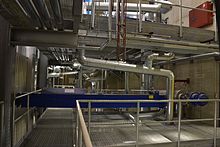
Summary
A sootblower is a device for removing the soot that is deposited on the internal furnace tubes of a boiler during combustion to prevent plugging of the gas passes and maintain boiler efficiency. The world market leader is Clyde Bergemann Power Group.

Types of soot blowers:
- Wall Blowers also known as IRs (Insertable Rotating)
- Long Retractable Sootblower (LRSB) or IK (Insertable Kinetic)
- Part-Retractable Sootblowers
- Oscillating Sootblowers
- Rake Sootblowers
- Air Heater Blower
- Rotating Element Sootblowers
- Multi-Media Sootblowers
- Fixed Rotating
Steam blowing medium:
- Steam
- Air
- High Pressure Water
- Dual-media air heater
Steam is normally used as a medium for blowing away the soot since capital cost of steam pressure reducing equipment and drain is less than the cost of compressors, motors and control of air systems.
Benefits of Sootblowers edit
- Increased plant availability
- Improved boiler and fired heater efficiency
- Controlled deposit build-up
- Reduced CO2 emissions
- Steam savings
- Optimised combustion process
- Increased energy recovery effectiveness
- Flexible operation for changing fuel mixture and varying fuel quality
Problems caused by soot edit
Reduced efficiency edit
Soot deposited on the heating surfaces of a boiler acts as a heat insulator. The result is that less heat is transferred to the water to raise steam and more heat is wasted up the chimney. This leads to higher fuel consumption and/or poor steaming.
Soot fires edit
A soot fire can be damaging to a boiler because it can cause localized hotspots to occur in the tubes. These hotspots may reach temperatures that weaken the materials of the tubes. Sootblowers reduce the risk of soot fires and their resulting damage.
Operation edit
A sootblower may be operated manually or by a remotely controlled motor. The soot, which is removed from the heating surfaces, will be blown out with the flue gases. If the boiler is equipped with a dust collector, it will trap the soot. Otherwise, the soot will be ejected into the outside air through the chimney stack.
Industries edit
A sootblower can make an important contribution for an optimised, more efficient and low-emission operation supporting clean energy generation in many industries, including:
- Power Industry
- Petrochemical Industry
- Waste-to Energy Plants
- Biomass Plants
- Marine
- Other Industrial Processes
See also edit
Boiler Monitoring / Cameras - Allows plant operators to accurately view and monitor internal furnace and process applications.
SMART Clean
External links edit
- Marine Engineer World
- [1] Boiler Efficiency - Clyde Bergemann (cbpg.com)


